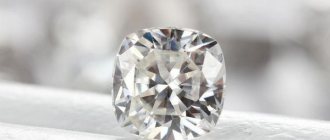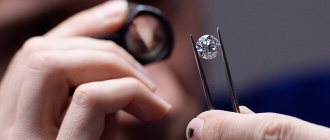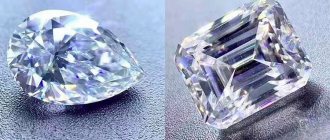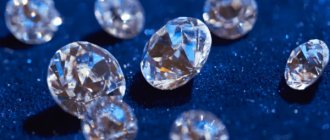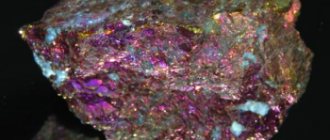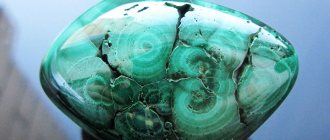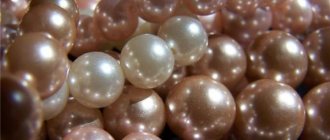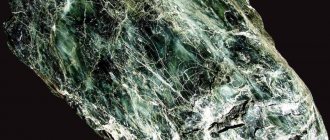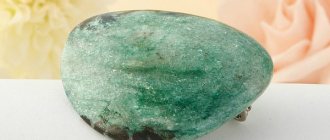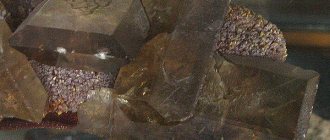An imitation diamond or a natural mineral that came to us from outer space? There are many different speculations surrounding moissanites. We invite you to take a closer look at the mysterious stone.
Moissanite is a rare gem. The amount of this beautiful mineral with a diamond luster is negligible in nature. It can only be found in corundum deposits, kimberlite rock and some meteorites. And this is the main thing to remember when you see the word “moissanite” on a jewelry label - it will always not be a natural stone, but its artificially grown brother - carborundum or silicon carbide.
But in space there is quite a lot of real moissanite. It is found in dust clouds formed from carbon. And the study of the Murchison meteorite led scientists to the conclusion that the silicon carbide it contains was formed far beyond the solar system.
What is moissanite
The name is given to a rare carbide mineral, which is colorless, shiny crystals. Gemologists, explaining what kind of moissanite stone it is, focus on the similarity of the structure with technical and synthetic jewelry samples. Natural gems are found in small quantities in individual meteorites, some corundum deposits, and kimberlites. The size of natural stone is a few millimeters. In laboratories, moissanites are grown large enough and of high quality so that they completely replace diamonds.
Most of the silicon carbides on the market are laboratory-made stones. The natural crystal was first found in 1893 in Arizona in a meteorite. Then it was possible to discover tiny hexagonal plates in the body of the meteorite. The name of the stone was given in honor of the meteorite researcher Henri Moisson. Even then, scientists doubted that the crystal was real, suggesting that it came from a researcher’s saw.
Heavenly Stone
Various methods and tests are used to identify imitation
Engagement ring with moissanite with a diameter of 7 mm. Photo: Love and Promise Jewelers
Optical test
You can notice the ghosting effect if the moissanite is placed under a microscope and adjusted so that the culet is visible and is located perpendicular to the platform. The focus should be concentrated a little lower.
Specific gravity
The test is based on the fact that the specific gravity of moissanite is slightly less than that of a diamond. The stones being examined are placed in a specially selected liquid, in which the diamonds sink and the moissanites float on the surface. But this method is not suitable for stones inlaid into jewelry, and the liquids themselves are usually toxic to humans.
Fire
The test should only be carried out if you are not afraid to sacrifice the moissanite, as the consequences for it will be irreversible. Light a match and place a stone under the fire. If the colorless crystal takes on a green tint and becomes smoky, then this is moissanite. The soot can be removed, but the shade cannot be changed.
Alan Hodgkinson Method
A gemologist from Scotland uses a visual method to identify moissanite. It involves holding the stone close to the eye and looking through it at the light source. The “pattern” of highlights on a diamond and a moissanite will be different, which is easy to notice even for a non-professional.
Hodgkinson has another method that can be used when you need to look at several stones at once (this will be useful for sellers who often buy 1-carat diamonds in bags of dozens of pieces).
It is necessary to pour the contents of the package into a transparent plastic lid and fill with water. Place a white sheet of paper under it. Now you need a table lamp that will illuminate the stones from above.
It is necessary to move the tray and use tweezers to move stone by stone. The reflections of stones on a sheet of paper will be different if moissanites are among them.
Story
The mineral moissanite is extremely rare on the planet, so it is considered heavenly. It is found in ancient meteorites that arrived in our planetary system from others. On Earth and even on our luminary, conditions are insufficient for a crystal to appear naturally. It turned out that such rock is formed near giant stars and during supernova explosions. In 1905, the gem was found in an Arizona meteorite while studying fragments of a celestial stone. Moisson, who was involved in this work, soon received the Nobel Prize. The new rock he discovered was dark green and splintered. Subsequently, similar ones were found inside diamonds and in several heavenly stones.
For a long time, the properties of the gem attracted geologists, but it was not possible to produce an alternative in laboratories. It was only by 1982 that the composition was studied well enough to think through the technology. The creation of large colorless crystals was realized in 1998. From this moment on, large jewelry samples are made in quantities that satisfy the industrial sector. Gemologists often call a rare mineral a jewel of the 21st century.
Guest from meteorites
Varieties and colors
According to modern classification, the mineral is divided into two types - natural (moissanite) and synthesized (carborundum):
- Natural, opaque stones are black and dark green in color, and their size is 0.5-4 mm.
- The artificial mineral can be presented in the form of 4-12 mm crystals, abrasive chips or powder.
In addition, scientists have learned to obtain such types of stone as:
- colorless, transparent imitation diamond;
- jewelry samples in blue, yellow, green, cognac and black shades;
- technical samples of purple, brown and other dark colors.
Physico-chemical characteristics
Main properties of a precious gem:
- colorlessness (or yellow, green, black color);
- greenish-gray streak;
- diamond shine, sometimes turning into metallic;
- transparency;
- hardness up to 9.5 units;
- unclear cleavage;
- axonal syngony;
- refraction up to 2.967 units.
Jewel of the 21st century
An artificial analogue of a diamond is superior to its relative in terms of jewelry quality and physical properties. Moissanite is brighter, sparkles stronger, and refracts light a quarter better than a natural cut diamond. The play of light is more intense, a rainbow appears even in low light. The only thing in which a gem is inferior to a diamond is hardness (9.5 versus 10).
Chemical and physical properties of moissanite
The chemical formula of the stone is SiC - silicon carbide. The hardness on the Mohs scale is 9.25, which is close to the standard diamond in this sense with its 10 units.
The color of natural moissanite is usually green or black, but in the case of a synthetic analogue, you can get any color or shade, although in 99% of cases colorless stones are used in jewelry to maximize the resemblance to natural diamonds. The refractive index reaches 2.69 (on average 0.25 higher than that of diamonds). The dispersion, which is responsible for the play of light, also exceeds the diamond indicator: for moissanite it is 0.104, and for diamonds it is 0.044.
However, let us remind you once again that we are talking about a synthetic analogue of a natural mineral. Natural moissanite is so rare that you will not find jewelry with this stone.
Deposits and processing
Moissanite is extremely rare. There is a chance of finding a natural sample in the following deposits:
- Ermakovskoe (Murmansk region);
- Emerald mines of the Middle Urals;
- Popigaisky crater in the Krasnoyarsk Territory;
- Uakit, Oshurkovsky massif in Transbaikalia;
- Udachnaya, World in Yakutia;
- Ust-Khannyinsky intrusion, Murunsky complex in Yakutia;
- Krivbass in the Dnepropetrovsk region;
- Pokrovo-Kireevskoye in Southern Donbass;
- Zhamanshin crater in Aktobe region.
Natural specimens are very rare
First attempts at synthesis
Man learned to synthesize moissanite before he discovered it in nature. This mineral is a chemical compound of silicon and carbon. Like many other precious stones, it is not only beautiful, but also has rare physical and chemical properties that are in demand in various industries.
The first successful attempts to synthesize silicon carbide were made at the end of the 19th century. And already in 1893, large-scale production was established. The material began to be used in the manufacture of electric furnaces, abrasives, radios and LEDs.
In 1995, a group of researchers from Charles & Colvard drew attention to the jewelry value of moissanite crystals. She patented technologies for the production of synthetic stones for jewelry purposes. The patent expired in 2015, allowing other companies to synthesize moissanites.
Production of synthetic moissanite
A jewelry crystal of natural origin is almost impossible. The deposits contain grains up to 4 mm in size. Known deposits can yield single gems. To solve the demand problem and fill the market with quality specimens, scientists have developed a method for making crystals in the laboratory. Colorless specimens and those colored in golden, yellow, green, and black shades are created. They weigh 0.01-14 carats. The smallest ones are used in paths and halos. In the descriptions of some earrings and rings you can see a mention of large moissanites - they are used to decorate the central part of the jewelry.
Commercial cultivation of stone used for jewelry was launched in the mid-90s of the last century. Charles and Colvard began production, but the monopoly did not last long. A decade later, the market was flooded with products from Russian, Indian, and Chinese laboratories. Now there are several large companies filling the international market with high quality samples. The leader is the American enterprise 3D-sorch, where the key technologists working with moissanite were Soviet emigrants. It is based on the Leili method developed by Tsvetkov and Tairov. Work begins at room temperature (silicon carbide sublimates into crystals) and continues when heated to 2400 degrees. A 200 gram crystal with excellent shine and hardness can be grown in just 15 hours.
An alternative production is the crystallization of liquid raw materials, distillation from steam into liquid and then into a solid. The second option requires silicon-containing methane.
Russian scientists have produced grey-green transparent crystals by sublimation under elevated pressure. For now, the method is used as an experimental one.
Jewelry is made in laboratories
How to distinguish from cubic zirconia
Cubic zirconia is an industrially produced mineral that has no natural analogue.
To distinguish it from moissanite, the thermal water content is checked - the indicator is much lower. Externally, cubic zirconia and gemstone are similar, so density and hardness are checked for diagnosis.
How to distinguish moissanite from diamond
It is very difficult to distinguish these breeds on your own. It is recommended to contact a specialist to evaluate the sample on the equipment.
Unusual valuable mineral
The gemologist will check:
- hardness (moissanite is slightly lower);
- purity (carborundum is higher due to its artificial origin);
- dispersion (carborundum has 2.5 times more);
- birefringence, presence of double ribs;
- heat resistance (moissanite changes color when heated at 65 degrees).
A laboratory stone is almost as good as a natural diamond.
Jewelry with moissanites
The cut mineral looks like a diamond. Moissanite is also dazzling in frames made of silver, platinum, pink, white, red, lemon gold.
Natural or synthesized stone looks best:
- in a set for the bride;
- rings (wedding, wedding, engagement);
- men's ring;
- long earrings, studs, studs;
- pendant;
- necklace, necklace;
- cufflinks;
- bracelet.
Jewelry with a sparkling stone is suitable for formal and evening wear. The style of clothing is selected according to the design and color of the frame of the product. Classic and romantic models are most often recommended.
It is not advisable to combine with other gems. It is forbidden to wear with ornamental stones.
Jewelry with moissanite should be visible:
- when using earrings, make high hairstyles;
- the necklace will suit dresses with an open neckline and shoulders;
- the sleeve should not cover the bracelet on the wrist;
- Gloves are not worn when wearing the ring.
View this post on Instagram
Posted by Gold&Diamonds shop (@5carats_shop) Oct 8, 2018 at 8:55 PDT
View this post on Instagram
Publication from TM Moissanite Ukraine (@moissanite.ua) Oct 11, 2018 at 12:02 PDT
View this post on Instagram
Publication from Jewelry Art Studio Koltsoff (@koltsoffart.ru) January 22, 2021 at 8:59 PST
View this post on Instagram
Posted by Evgeniy Rublev JEWELER (@evgeniyryblev23) Oct 27, 2017 at 8:25 PDT
Jewelry with moissanite is stored in separate cases or bags. Removed before physical work, gymnastics. It is recommended to clean the products after each wear. Jewelers clean with ultrasound.
At home, remove grease, cosmetics and other organic dirt with a soft brush and water with dish gel. After cleaning, the product is washed under the tap. The temperature of the liquid should approach 30 ºC. Afterwards, wipe with a cloth, dry with a hairdryer, and polish with a napkin.
Instead of gel, use an ammonia solution. Combine 3 parts cold water and 1 part ammonia. The decoration is immersed in the liquid for 10 minutes. Then the product is brushed, washed, dried, and polished.
Moissanite and diamond
Although artificial stone is usually inferior to natural stone, transparent moissanite is an exception. It is no different from a diamond in appearance, only slightly inferior in hardness, and refracts light much better. Among artificially produced stones, the diamond analogue is the most expensive.
Price is one of the advantages of natural stone. A diamond is a good investment whose value increases over the years. True, it is very difficult to get the full price when selling jewelry; it takes a lot of time.
Laboratory stone is not inferior to natural stone
Jewelry market experts advise choosing a natural diamond if you need a small stone, and moissanite for those who need a large specimen. Jewelry with a laboratory gem is ideal for events with a large number of participants, where the product can be lost. If an accident occurs, the losses will be relatively small.
Areas of application
Both natural and artificial stones have a great resemblance to a diamond, while a diamond is harder, less fire-resistant, and is slightly inferior in beauty to its counterpart. This is why moissanite is highly valued by jewelers and collectors.
Also read: Chiastolite - the magic of a mysterious stone
In addition to jewelry, artificial stone is widely used in industry. With its help they make:
- abrasive tools;
- covering sections of body armor;
- composite armor;
- protection of devices from overvoltage;
- transistors;
- diodes, semiconductors, sealing parts;
- telescopic optics;
- heating elements;
- disc brakes;
- diesel filters.
In addition, it is a catalyst for the oxidation of hydrocarbons and is used for the synthesis of graphene and in nuclear energy.
How to care
With improper, irregular care, the gem loses its shine. To return it, they check for damage. You won’t be able to restore the crystal’s beauty on your own, but you can worsen the condition with unprofessional actions, so it’s better to immediately take the specimen to a jeweler. Using special equipment, he will check internal and external damage and process the jewelry with a laser. Microcracks are filled with special glue.
Store moissanite in a special box separately from other items so as not to scratch it.
If dust appears on the stone, wash the jewelry with soapy water, wipe it with alcohol, and with jewelry napkins made of non-woven material. It is forbidden to rub the object with force; use vinegar, potassium permanganate, or hydrogen peroxide for cleaning. If the contamination is severe, the item is taken to a jeweler for ultrasonic cleaning.
The stone requires maintenance
Difference from a diamond
Moissanite is distinguished by its unique play of reflections on its edges. Considering that its characteristics are not inferior to those of diamond, it has turned out to be a real treasure for the jewelry industry. The price of an artificial stone is significantly lower than a diamond, but it is very difficult to distinguish it.
There are various methods to verify the authenticity of diamonds:
- Electronic tester. The device is equipped with a screen with an arrow and a special probe, which is brought to the stone. During diagnostics, the electrical and thermal conductivity of the gem is measured. The needle of the device will accurately show the nature of the mineral and reveal its true origin.
- Visual determination of the birefringence effect characteristic of moissanite.
- Using an ultraviolet lamp. In its rays, carborundum acquires a slight yellow or green fluorescence.
- Recognition of the specific gravity of a mineral using special liquids. For diamond and carborundum, these meanings are different, and an experienced jeweler will be able to establish the truth if the gem is not set in a precious metal.
There are also traditional methods to distinguish a diamond from moissanite. If you breathe on a stone and it does not become cloudy and remains crystal clear, then it is a diamond. Moisture does not linger on its surface and quickly evaporates. If carborundum is brought to an open flame, it will acquire a greenish tint. The changes will be irreversible, and the cost of the stone will decrease significantly.
But when buying in a jewelry store, it is better to take the advice of an independent jeweler or reliable testing. Moissanite will not lose its value for many years and will remain the best of the artificially grown minerals.
Magic properties
Artificial stone has healing, magical properties
The gem influences human consciousness and supports in difficult periods of life. Breed:
- protects;
- calms;
- expels phobias;
- increases self-confidence;
- gives determination;
- helps to choose a direction;
- contributes to achieving goals.
Moissanite is a source of positive energy that protects against the evil eye.
Compatibility with zodiac signs
(“+++” – the stone fits perfectly, “+” – can be worn, “-” – is strictly contraindicated):
| Zodiac sign | Compatibility |
| Aries | +++ |
| Taurus | + |
| Twins | +++ |
| Cancer | + |
| a lion | +++ |
| Virgo | + |
| Scales | +++ |
| Scorpion | + |
| Sagittarius | +++ |
| Capricorn | + |
| Aquarius | +++ |
| Fish | + |
Moissanite is most suitable for representatives of air or fire signs.
For Sagittarius, Aries, Gemini, Aquarius, Leo and Libra, the stone helps to establish the psycho-emotional sphere and also attracts finances.
It also helps Capricorns, Virgos, Taurus, Scorpios, Pisces and Cancers to acquire and protect material wealth.
Moissanite price per 1 carat
The price of 1 carat of cut stone without color reaches $300. Green copies are 30% cheaper, and yellow and brown ones are almost 2 times less. It is not economically feasible to produce small moissanite stones up to 2 mm: they cost almost the same as natural diamonds.
The cost of jewelry with colorless moissanite weighing 0.1 carats starts from 10 thousand rubles. (ring or earrings) .
